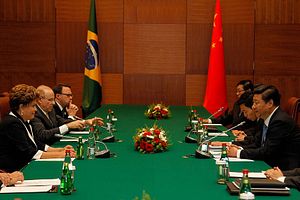As Xi Jinping travels through South America this week, China’s goals for the region are on display. Even though Xi ’s tour of South America only sees him stopping in three countries (Brazil, Venezuela, and Argentina), he has arranged meetings with even more leaders, including the presidents of Ecuador, Peru, and Bolivia. Amidst all the diplomatic niceties, what does China actually want to achieve with Xi’s trip?
The most obvious priority is expanding economic ties between China and South America. Trade between China and Latin America (a region encompassing South America, Central America, and the Caribbean) has skyrocketed in the past 15 years, rising from a total value of $12 billion in 2000 to $261 billion in 2013. And there’s still room for growth, as China’s bilateral trade volumes with individual countries remain relatively low. China has grown to be Latin America’s second largest trading partner and may ultimately has its sights set on replacing the U.S. for the top position.
In addition to the economic benefits of trade, China has strategic interests in South America as a source for energy, agricultural imports, and other natural resources. As a growing power, China wants as much diversity in its energy imports as possible, particularly giving growing uncertainties in the Middle East. China has long had a good relationship with oil exporter Venezuela, and has increasingly sought to invest in Brazil’s oil industry as well.
China also has its eye on investing in South American infrastructure, an area where it is already doing well. Chinese company CNR Corporation Ltd. was the major beneficiary of Rio de Janeiro’s push to improve its railway networks prior to the 2014 World Cup and 2016 Summer Olympics. Xi also took the time during his visit to personally promote plans for a trans-continental railroad that would stretch from Peru’s western coast to Brazil’s east coast. China, Brazil, and Peru would cooperate on the project.
Importantly, though, China uses such projects not only as an economic boost, but also as a diplomatic tool. Cooperation on infrastructure projects and other development initiatives is held up as evidence of China’s benevolence towards other developing nations. A quote from Ecuadorian President Rafael Correa is telling in this regard. “Ecuador, as one of the smallest countries in South America, receives respect from China who offers help to the country’s social and economic development, and the Ecuadorian people’s life is bettered thanks to China’s support in many development projects,” Xinhua quoted Correa as saying.
Thus, an economic push by China is also a soft power push, as Beijing uses its funding (both public and private) to win goodwill in developing countries. This is also accompanied by China’s hope to increase cultural exchanges and establish more Confucius Institutes in the region. There are currently 32 Confucius Institutes in Latin America, according to Xinhua.
It’s China’s hope that economic support and soft power will translate to political backing, a strategy that Beijing has used in Africa as well. In fact, Xi’s speech to the Brazilian National Congress focused more on political partnership than on economic cooperation. Xi invited Brazil to share in a new “security concept,” echoing his previous speech on a new security concept at CICA. He also called for more cooperation between China and Brazil on international issues, including upholding each other’s “sovereignty, security, and territorial integrity.”

































